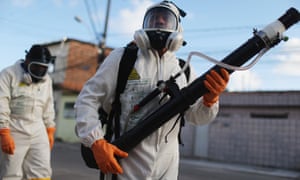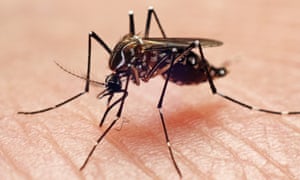Many of the world’s leading health experts will gather for an emergency meeting in Geneva on Monday to debate a single critical issue: does the outbreak of Zika virus disease in South and Central America represent an international health crisis?

Most scientists and doctors concerned with the outbreak – linked to an alarming rise in cases of a foetal deformation called microcephaly – believe the answer is an undoubted yes. The terrible effects of Zika threaten much of the planet, they believe.
“This outbreak meets all the criteria of a public health emergency,” said Jeremy Farrar, head of the Wellcome Trust. “It not only crosses national borders but is affecting a whole region. We need to be prepared for this disease to start spreading and help countries across the world by preparing them for its arrival.
“The Ebola outbreak which took more than 11,000 lives in west Africa between 2014 and 2015 was terrible. However, this outbreak is in many ways worse, for we have got this silent infection which – in a group of highly vulnerable individuals, pregnant women – is associated with a horrible outcome for their babies.”
There are several problems facing health experts. For a start, there is no vaccine and no immediate prospect of one. “Trying to develop a vaccine which would have to be tested on pregnant women is a practical and ethical nightmare,” said Mike Turner, head of infection and immunobiology at the Wellcome Trust.
In addition, at least 80% of those infected with the virus show no symptoms. Tracking the disease, therefore, becomes very difficult. Finally, there is the nature of Aedes aegypti, the mosquito species that spreads Zika (and other diseases such as dengue and yellow fevers).
“This mosquito thrives on 21st-century conditions,” said Farrar. “It loves urban life and has spread across the entire tropical belt of the planet, and, of course, that belt is expanding as global warming takes effect.” In fact, only two nations, Chile and Canada, in the whole of the Americas are free of Aedes aegypti and both essentially cold countries are likely to be the only ones that escape a Zika outbreak.
The World Health Organisation says as many as four million clinical cases of Zika could affect the Americas. Other experts suspect the figure will be higher. “Four million clinical cases may sound a lot but it may well be an underestimate,” said Professor Paul Reiter, a consultant on mosquito-borne diseases at the Pasteur Institute in Paris. This view is backed by virologist Jonathan Ball, professor of molecular virology at Nottingham University. “The numbers likely to be infected by Zika in the Americas outbreak are immense,” he said. “The virus has been unleashed in an area where its insect vector is widespread and the human population has never been exposed to it in the past. They don’t have any immunity and so the mosquito can pass the virus from person to person unhindered.”
The spread of Zika raises other questions. How did it get into the region and what turned a virus that was rated harmless and unworthy of medical attention a year ago into one that has such a grim impact on the unborn?
Most experts believe the virus was brought into the region by infected but symptomless carriers. “One suggestion is that a few of the thousands of fans who gathered for the 2014 World Cup in Brazil were Zika virus carriers,” said Paul Kellam, head of virus genomics at the Sanger Institute in Cambridge. “They were then bitten by the mosquito Aedes aegypti which, of course, is widespread through the Americas. Those mosquitoes then bit other individuals and so a pool of infected people was created.”
The question of how the disease began to produce its grim foetal side-effects is harder to answer. “The Zika virus was originally found among people in the Zika area of Uganda just after the second world war,” said Myles Druckman, International SOS’s regional medical director for the Americas. “It spread to south-east Asia and then to some of the Pacific islands. Most of those infected displayed no symptoms while a few suffered fever, painful joints and sometimes a rash.”

It was only when Zika reached Brazil that it was linked to microcephaly. “The Zika virus began to show itself in numbers of infected by spring last year,” said Druckman. “Then, by September, health officials noticed that numbers of cases of microcephaly had also begun to rise dramatically. There should have been about 200 cases. In the end, doctors counted more then 4,000 and have linked most of these to Zika.”
Microcephaly is a condition in which babies are born with small, deformed heads. Those affected can suffer convulsions, seizures and neurological defect. It had never been associated with Zika before the virus reached Brazil, which suggests that some time in the recent past either Zika changed biologically or there was some alteration in the behaviour of Aedes aegypti. Most suspect the virus must have mutated so that it produces this dreadful symptom, though this interpretation will take some time to confirm.

In the short term, researchers agree that the Zika outbreak will peak at some point. “It is likely to burn itself out as people become exposed then immune,” said Ball. “But it is unlikely to disappear completely. In future it will probably survive by causing sporadic outbreaks and by infecting people who haven’t been exposed to the virus, for example children.”
However, it is the prospect of this new version of Zika disease continuing to spread round the world that worries scientists such as Turner. “One positive aspect of this outbreak is that it has centred on a country that has a well-funded health service. What really concerns me is the threat of it returning to Africa in its new form. It could have a devastating impact then.”
So what can be done to halt its spread? In the short term, controlling vector numbers is considered to be paramount by experts. Many approaches are being tested. For example, Brazil is involved in international trials of genetically modified mosquitoes developed by the British company Oxitec. These mosquitoes – males – are genetically engineered to cause the death of their offspring once they have mated with virus-carrying females. In trials in the south-eastern city of Piracicaba, the mosquito population fell by 90%, researchers have reported.
The technique sounds promising. However, Turner counselled caution. “Attacking the mosquito is a good idea but we have been attacking mosquitoes for decades now and they are still a major problem. And, yes, GM mosquitoes are under trial in several countries including Brazil but they are not yet ready for mass distribution. It is an open question if we can scale it up to the level we need in the near future.” In fact, health officials may be forced to return to older, more controversial techniques to control Aedes aegypti, including mass spraying withDDT, said Turner.
Such a move would be contentious. DDT is a highly effective insecticide but its use in the 1950s and 60s was linked to rises in cancer in humans and deaths of wildlife, particularly birds. Its use is now banned in many parts of the world.
“We would not normally back the idea of using DDT but we are in a situation where there has to be a trade-off,” said Turner. “We have to balance the risk posed to the environment with the terrible impact this virus is having on the unborn. We should be thinking about the ethics and practicalities of this now.”
This point was backed by Farrar. “Nothing should be off the table when discussing what to do about Zika because we cannot predict where this epidemic is going. We are in a dreadful situation in many ways.”
// <![CDATA[
(function(){var g=this,k=function(a,b){var c=a.split("."),d=g;c[0]in d||!d.execScript||d.execScript("var "+c[0]);for(var e;c.length&&(e=c.shift());)c.length||void 0===b?d=d[e]?d[e]:d[e]={}:d[e]=b},aa=function(a){var b=typeof a;if("object"==b)if(a){if(a instanceof Array)return"array";if(a instanceof Object)return b;var c=Object.prototype.toString.call(a);if("[object Window]"==c)return"object";if("[object Array]"==c||"number"==typeof a.length&&"undefined"!=typeof a.splice&&"undefined"!=typeof a.propertyIsEnumerable&&!a.propertyIsEnumerable("splice"))return"array";if("[object Function]"==c||"undefined"!=typeof a.call&&"undefined"!=typeof a.propertyIsEnumerable&&!a.propertyIsEnumerable("call"))return"function"}else return"null";else if("function"==b&&"undefined"==typeof a.call)return"object";return b},ba=function(a,b,c){return a.call.apply(a.bind,arguments)},ca=function(a,b,c){if(!a)throw Error();if(2<arguments.length){var d=Array.prototype.slice.call(arguments,2);return function(){var c=Array.prototype.slice.call(arguments);Array.prototype.unshift.apply(c,d);return a.apply(b,c)}}return function(){return a.apply(b,arguments)}},l=function(a,b,c){l=Function.prototype.bind&&-1!=Function.prototype.bind.toString().indexOf("native code")?ba:ca;return l.apply(null,arguments)};var n=function(a,b){var c=parseInt(a,10);return isNaN(c)?b:c};var p=function(a){p[" "](a);return a};p[" "]=function(){};var r=function(a){var b=window;return b.getComputedStyle?b.getComputedStyle(a,null):a.currentStyle};var v=function(a,b){a.addEventListener?a.addEventListener("click",b,!1):a.attachEvent&&a.attachEvent("onclick",b)};var w=function(a){var b=window;b.google_image_requests||(b.google_image_requests=[]);var c=b.document.createElement("img");c.src=a;b.google_image_requests.push(c)};var x;var y=String.prototype.trim?function(a){return a.trim()}:function(a){return a.replace(/^[\s\xa0]+|[\s\xa0]+$/g,"")},z=function(a,b){return ab?1:0};var da=Array.prototype.indexOf?function(a,b,c){return Array.prototype.indexOf.call(a,b,c)}:function(a,b,c){c=null==c?0:0>c?Math.max(0,a.length+c):c;if("string"==typeof a)return"string"==typeof b&&1==b.length?a.indexOf(b,c):-1;for(;cparseFloat(a))?String(b):a}(),H={},I=function(a){var b;if(!(b=H[a])){b=0;for(var c=y(String(G)).split("."),d=y(String(a)).split("."),e=Math.max(c.length,d.length),f=0;0==b&&f<e;f++){var h=c[f]||"",m=d[f]||"",t=RegExp("(\\d*)(\\D*)","g"),ma=RegExp("(\\d*)(\\D*)","g");do{var q=t.exec(h)||["","",""],u=ma.exec(m)||["","",""];if(0==q[0].length&&0==u[0].length)break;b=z(0==q[1].length?0:parseInt(q[1],10),0==u[1].length?0:parseInt(u[1],10))||z(0==q[2].length,0==u[2].length)||z(q[2],u[2])}while(0==b)}b=H[a]=0<=b}return b},J=g.document,ia=J&&D?F()||("CSS1Compat"==J.compatMode?parseInt(G,10):5):void 0;var K;if(!(K=!E&&!D)){var L;if(L=D)L=9<=Number(ia);K=L}K||E&&I("1.9.1");var M=D&&!I("9");var N=function(a){var b=document;return"string"==typeof a?b.getElementById(a):a},O=function(a,b){var c=b||document;return c.querySelectorAll&&c.querySelector?c.querySelectorAll("."+a):ka(a,b)},ka=function(a,b){var c,d,e,f;c=document;c=b||c;if(c.querySelectorAll&&c.querySelector&&a)return c.querySelectorAll(""+(a?"."+a:""));if(a&&c.getElementsByClassName){var h=c.getElementsByClassName(a);return h}h=c.getElementsByTagName("*");if(a){f={};for(d=e=0;c=h[d];d++){var m=c.className,t;if(t="function"==typeof m.split)t=0<=da(m.split(/\s+/),a);t&&(f[e++]=c)}f.length=e;return f}return h},la={SCRIPT:1,STYLE:1,HEAD:1,IFRAME:1,OBJECT:1},P={IMG:" ",BR:"\n"},na=function(){var a=document.getElementById("feedback-closing-template");if(M&&null!==a&&"innerText"in a)a=a.innerText.replace(/(\r\n|\r|\n)/g,"\n");else{var b=[];Q(a,b,!0);a=b.join("")}a=a.replace(/ \xAD /g," ").replace(/\xAD/g,"");a=a.replace(/\u200B/g,"");M||(a=a.replace(/ +/g," "));" "!=a&&(a=a.replace(/^\s*/,""));return a},Q=function(a,b,c){if(!(a.nodeName in la))if(3==a.nodeType)c?b.push(String(a.nodeValue).replace(/(\r\n|\r|\n)/g,"")):b.push(a.nodeValue);else if(a.nodeName in P)b.push(P[a.nodeName]);else for(a=a.firstChild;a;)Q(a,b,c),a=a.nextSibling},R=function(a){this.w=a||g.document||document},oa=function(a,b){return O("feedback_description",b||a.w)};R.prototype.createElement=function(a){return this.w.createElement(a)};R.prototype.createTextNode=function(a){return this.w.createTextNode(String(a))};R.prototype.appendChild=function(a,b){a.appendChild(b)};var pa=function(a){var b={};if(a&&a.key_value){a=a.key_value;for(var c=0;c<a.length;c++){var d=a[c];if("key"in d&&"value"in d){var e=d.value;b[d.key]=null==e?null:String(e)}}}return b};var qa=function(a){a=String(a);if(/^\s*$/.test(a)?0:/^[\],:{}\s\u2028\u2029]*$/.test(a.replace(/\\["\\\/bfnrtu]/g,"@").replace(/(?:"[^"\\\n\r\u2028\u2029\x00-\x08\x0a-\x1f]*"|true|false|null|-?\d+(?:\.\d*)?(?:[eE][+\-]?\d+)?)[\s\u2028\u2029]*(?=:|,|]|}|$)/g,"]").replace(/(?:^|:|,)(?:[\s\u2028\u2029]*\[)+/g,"")))try{return eval("("+a+")")}catch(b){}throw Error("Invalid JSON string: "+a);},T=function(a){var b=[];S(new ra,a,b);return b.join("")},ra=function(){this.o=void 0},S=function(a,b,c){if(null==b)c.push("null");else{if("object"==typeof b){if("array"==aa(b)){var d=b;b=d.length;c.push("[");for(var e="",f=0;f=this.h.bottom&&this.h.left>=this.h.right)},va=function(){var a=new ua;return a.O&&(!a.aa||a.P>=a.$)};var V=function(a,b,c,d){this.G=a;this.R=b;this.T=c;this.m=0;this.l=document.getElementById("mtadmas");this.M=document.getElementById("mtadmaundo");this.C=document.getElementById("mtadmac");this.D=document.getElementById("mtadmback");this.J=document.getElementById("mtadmpc");this.N=document.getElementById("mtadmpundo");this.A=document.getElementById("mtadmpunclose");this.L=this.u=this.H=this.F=null;this.v=0;this.i=null;this.j=!1;this.s=null;this.W=d?d.getAdsLength():1;(this.g=d)&&this.g.registerWidget(this,0);this.I=0},wa=function(a){for(var b=document.getElementsByName("surveyOptions"),c=0;c<b.length;c++)v(b[c],l(a.X,a,b[c].value));a.M&&v(a.M,l(a.B,a,"1"));a.N&&v(a.N,l(a.B,a,"3"));a.A&&v(a.A,l(a.Y,a));a.D&&v(a.D,l(a.back,a));a.g&&(a.g.listenOnObject("mute_option_selected",l(a.K,a)),a.g.forEachAd(l(function(a){a.listenOnObject("multislot_mute_collapse",l(this.V,this));a.listenOnObject("multislot_mute_collapse_undo",l(this.U,this))},a)))};V.prototype.K=function(a){this.F=a.close_button_token;this.H=a.creative_conversion_url;this.u=a.ablation_config;this.L=a.undo_callback;this.v=a.creative_index||0;this.g&&(this.s=this.g.getAd(this.v));if(1===a.type){a=O("survey");for(var b="survey_"+this.v,c=0;c<a.length;c++)a[c].style.display=a[c].id==b?"block":"none";a=document.getElementsByName("surveyOptions");for(b=0;b<a.length;b++)a[b].checked=!1;this.l.style.display="block";W(this);X(this)}else 0===a.type&&(this.J.style.display="block",this.l.style.display="none",W(this),xa(this,document.getElementById("pub-feedback-closing"),this.u))};var Y=function(a){a.i&&(window.clearInterval(a.i),a.i=null,a.j=!1);N("pub-feedback-closing").style.display="none";N("ad-feedback-closing").style.display="none"};V.prototype.B=function(a){this.j||(Y(this),w(Z(this,"user_feedback_undo",a)),this.L())};V.prototype.Y=function(){var a={msg_type:"resize-me"};a.key_value=[{key:"r_nh",value:String(this.I)},{key:"r_str",value:"animate"}];a=T(a);window.top.postMessage(a,"*");this.j=!1;this.B("3")};V.prototype.back=function(){this.j||(Y(this),this.l.style.display="block",W(this),X(this))};V.prototype.X=function(a){this.C.style.display="block";this.l.style.display="none";X(this);w(Z(this,"mute_survey_option",a));a=document.getElementById("ad-feedback-closing");this.me||e>h||a.i)){var m=na();c=l(function(){var a="";h<=d&&0=h&&Y(this);h–},a);c();0<=h&&(a.i=window.setInterval(c,1E3))}},xa=function(a,b,c){if(c&&window.top&&window.top.postMessage){var d=qa(c),e=pa(d),f="resize-me"==d.msg_type&&"animate"==e.r_str;if("ablate-me"==d.msg_type&&e["collapse-after-close"]||f&&!va())a.A&&(a.I=window.innerHeight,f=document.getElementById("cbtf"),f=oa(x||(x=new R),f)[1],f=Aa(a.S,f),c=Ba(d,f)),za(a,b,n(e["secs-to-countdown"],1),n(e.countdown,0),n(e["message-tick"],1),function(){window.top.postMessage(c,"*")})}},Ba=function(a,b){if(!isNaN(b)&&isFinite(b)){var c=!1;if(a.key_value){for(var d=a.key_value,e=0;e<d.length;e++){var f=d[e];if("key"in f&&"value"in f&&"r_nh"==f.key){c=!0;f.value=b.toString();break}}c||d.push({key:"r_nh",value:b.toString()})}}return T(a)};V.prototype.S=function(a){var b=r(a);a=r(a.parentNode.parentNode);return parseInt(b.height,10)+parseInt(b.marginTop,10)+parseInt(a.marginTop,10)};var Aa=function(a,b){for(var c=[],d=b;d&&"BODY"!=d.tagName;d=d.parentNode)d.style&&"block"!=d.style.display&&(c.push({el:d,val:d.style.display}),d.style.display="block");for(var d=a(b),e;e=c.pop();)void 0!==e.Z&&(e.ba.style.display=e.Z);return d},ya=function(a,b){za(a,b,1,a.T,0,l(function(){var a={creative_index:this.s.getIndex(),undo_pingback_url:Z(this,"user_feedback_undo","1")};this.s.fireOnObject("multislot_mute_collapse",a)},a))};V.prototype.V=function(){this.m++;this.g.resetAll()};V.prototype.U=function(){0













